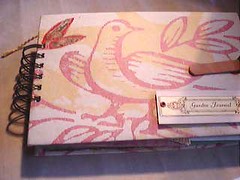I hope everyone is having a great week! I am really looking forward to the weekend myself. I’ve been admiring all the work I did in the yard last weekend and I can’t wait to add to it! In the meantime, I worked up a garden planner in my garden journal today so I know when to do what. I’ve been keeping a journal since I first started my garden, and it’s come in very handy from season to season to track what I’ve done and what works or doesn’t. I like to keep my seed packets with my plans and keep track of when I plant, fertilize, water and harvest. It’s also important not to plant the same things in the same place every year since it depletes the soil of all the vital nutrients needed for your fruits and veggies to grow and produce. I take notes in my journal about the progress of the plants, when they bloomed, etc. And finally, I write down what pests I had to deal with for which plants, so I know what to do in the future to prevent them or kill them. Since I have an organic garden, I like to prevent them if at all possible.
To create your own journal, you’ll want to get a notebook or binder with pockets. I like the 3-subject notebooks that have pockets in the dividers for this project. I keep empty seed packets in the pockets so I can refer to them whenever I’m struggling with something. On the top of the each section, I write “Spring Garden,” “Fall Garden” and leave the last section for notes. In the Spring and Fall section, I list what I plan on planting. I usually draw a diagram of the raised bed in our yard, and then draw in the plants where I intend to put them based on where they were last year, what their watering needs are, and whether I need to plant something tall around them to protect from the harsh summer sun. This is especially important to me since our bed gets direct afternoon sun all summer long. In Phoenix, this can be deadly to my crops if I don’t offer some sort of protection. After you figure out what is going where, you’ll want to write down the date everything was planted and when their expected harvest times are. This is helpful for when things are taking too long. It’s always so frustrating for me to watch seedlings grow because they move so slowly at first! The harvest date keeps me motivated 😉
After you get all this down in your journal, you may want to create a planner like I do. Here is what mine looks like (all info obtained from Extreme Gardening: How to Grow Organic In The Hostile Deserts by Dave Owens “The Garden Guy”):
Pumpkins:
- Water to 24″, don’t let soil dry out
- Fertilize with fish emulsion or liquid seaweed every 2 weeks–heavy feeder
- Keep mulch 4″-6″
- Protect from birds and use DE for beetles if needed (*DE= Diatomaceous Earth)
- Plant second crop in July for Halloween pumpkins
Spinach & Lettuce:
- Keep mulch 4″-6″ but away from stems
- Don’t let soil dry out, water 12″-18″
- Fertilize with liquid seaweed every 2 weeks
Kale:
- Keep mulch 4″-6″ high but away from stems
- Water deeply to 18″ and keep moist
- Fertilize with fish emulsion every 2-3 weeks
- Pick outer leaves for harvest when they are 3″-5″ long or they will be tough
Tomatoes:
- Water to 23″ but don’t over-water or under-water
- Mulch 4″-6″ high
- Fertilize with liquid seaweed every 2 weeks
Bell Peppers:
- Don’t let soil dry out, water 18″-24″ and keep soil moist
- Three weeks after planting, sprinkle blood meal around plant
- Four weeks after planting, sprinkle epsom salts on the plant
- Fertilize with fish emulsion every 2 weeks
- Mulch 4″-6″ high
Artichokes:
- Water 2′-3′ deep
- Mulch 4″-6″ thick but don’t touch the stem
- Harvest often, once the buds open and flower the plant stops producing
- Cut back in June, stop watering until August
- Fish emulsion in August for a second crop
I will usually mark all of this on a calendar so that I have a quick reference of To Do’s. I learned early on that keeping a garden journal was really pretty essential to making things grow, but since I’m fairly new to this, it’s only now that I have enough info to look back on so I can try not to make the same mistakes as I have in the past. Hopefully, your garden journal will help you have a successful harvest too!





